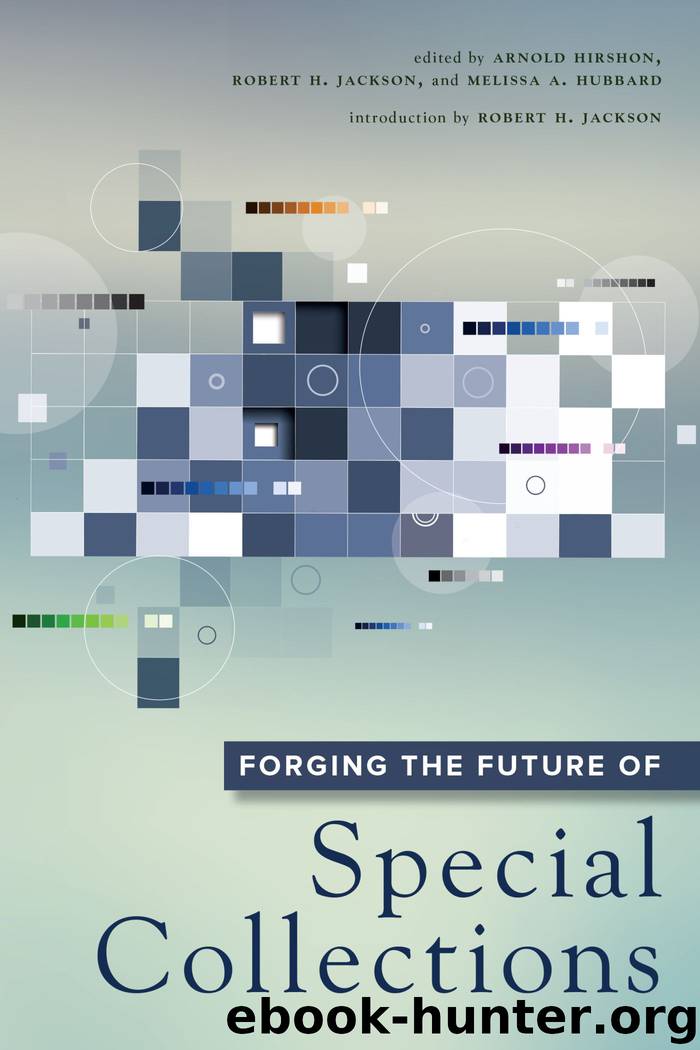Forging the Future of Special Collections by Arnold Hirshon & Robert H. Jackson & Arnold Hirshon

Author:Arnold Hirshon & Robert H. Jackson & Arnold Hirshon [Hubbard, Melissa A.]
Language: eng
Format: epub
Tags: LAN025040 Language Arts & Disciplines / Library & Information Science / Collection Development
ISBN: 9780838914236
Publisher: American Library Association
Published: 2016-06-08T16:00:00+00:00
NOTES
1. Charles Olson, Human Universe (New York: Grove Press, 1958).
2. Pierre Teilhard de Chardin, The Vision of the Past (New York: Harper & Row, 1966), 71, 230, 261.
CHAPTER 13
Objects of Study
Special Collections in an Age of Digital Scholarship
STEPHEN ENNISS
In 1794 Samuel Ireland announced the discovery of a trove of Shakespeare letters and manuscripts, including what he claimed was the original manuscript of King Lear. The public interest in the discovery was so great that tickets had to be distributed to manage the number of people that wished to crowd into Ireland’s home to see the papers. Hearing of the discovery, the diarist James Boswell joined the crowds, and, upon seeing the manuscript, is said to have kissed it and then remarked, “I shall now die contented, since I have lived to witness the present day.”1 Boswell apparently meant it; he was dead within a few weeks.
The Ireland forgeries, as they are now known, were only exposed as fakes when the forger, Samuel Ireland’s own son, William, tried to pass off an entire play of his own fabrication as a newly discovered work by Shakespeare. Plans were made to produce Vortigern and Rowena at London’s Drury Lane Theatre, but on opening night the audience saw through the obvious fraud and disrupted the performance with derisive laughter. The disturbance was so great the actors were unable to go on.
I am interested in the Ireland forgeries not out of any particular interest in fraud but for what the story tells us about the status of the manuscript at the end of the eighteenth century. If nothing else, the literary manuscript was a revered enough object to be worth forging. The public would pay to see it and to be in its presence.
I would like to consider the manuscript, the letter, and other objects of study that make up our research institutions’ rich archival collections. I’m particularly interested in how our attitudes towards these objects have shifted over time, what has remained the same, and what opportunities may be posed by the fundamental change in the nature of the contemporary archive.
Download
This site does not store any files on its server. We only index and link to content provided by other sites. Please contact the content providers to delete copyright contents if any and email us, we'll remove relevant links or contents immediately.
Cecilia; Or, Memoirs of an Heiress — Volume 1 by Fanny Burney(31352)
Cecilia; Or, Memoirs of an Heiress — Volume 3 by Fanny Burney(30950)
Cecilia; Or, Memoirs of an Heiress — Volume 2 by Fanny Burney(30907)
The Great Music City by Andrea Baker(21621)
We're Going to Need More Wine by Gabrielle Union(18088)
Bombshells: Glamour Girls of a Lifetime by Sullivan Steve(13120)
Pimp by Iceberg Slim(12948)
All the Missing Girls by Megan Miranda(12776)
Fifty Shades Freed by E L James(12464)
Talking to Strangers by Malcolm Gladwell(11909)
Norse Mythology by Gaiman Neil(11902)
Crazy Rich Asians by Kevin Kwan(8373)
Mindhunter: Inside the FBI's Elite Serial Crime Unit by John E. Douglas & Mark Olshaker(7850)
The Lost Art of Listening by Michael P. Nichols(6485)
Enlightenment Now: The Case for Reason, Science, Humanism, and Progress by Steven Pinker(6415)
Bad Blood by John Carreyrou(5782)
The Four Agreements by Don Miguel Ruiz(5533)
Weapons of Math Destruction by Cathy O'Neil(5049)
We Need to Talk by Celeste Headlee(4881)
